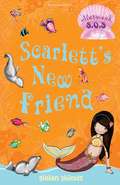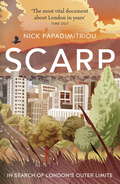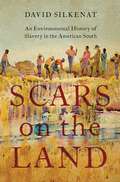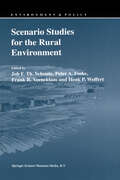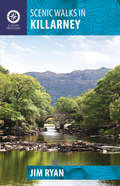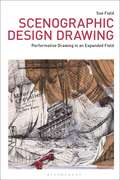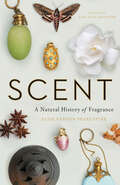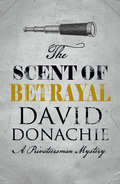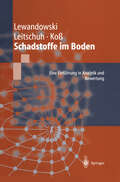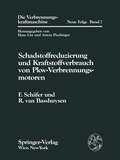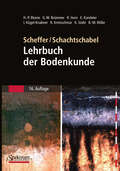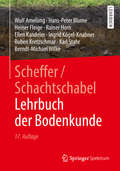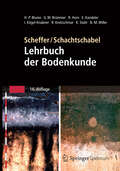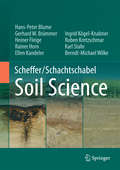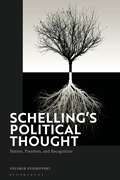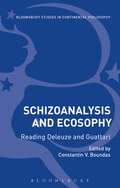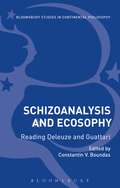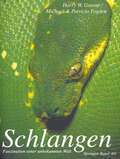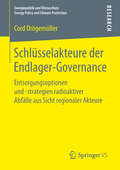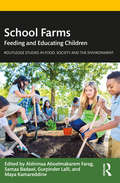- Table View
- List View
Scarlett's New Friend: Mermaid S.O.S.
by Gillian ShieldsScarlett and her fellow Sisters of the Sea are only a day away from Coral Kingdom and completing their mission! But the evil Mantora is still trying to stop them, this time littering a nearby beach with garbage. Scarlett's got to stop being bossy and learn to make friends to get the beach cleared in time.
Scarp
by Nick PapadimitriouNick Papadimitriou has spent a lifetime living on the margins, walking and documenting the landscapes surrounding his home in Child's Hill, North London, in a study he calls Deep Topography. Part meditation on nature and walking, part memoir and part social history, his arresting debut is first and foremost a personal inquiry into the spirit of a place: a 14-mile broken ridge of land on the fringes of Northern London known as Scarp. Conspicuous but largely forgotten, a vast yet largely invisible presence hovering just beyond the metropolis, Scarp is a vast storehouse of regional memory. We join the author as he explores and reimagines this brooding, pregnant landscape, meticulously observing his surroundings, finding surprising connections and revealing lost slices of the past. SCARP captures the satisfying experience of a long, reflective walk. Whether talking about the beauty of a bird or a telegraph pole, deaths at a roundabout or his own troubled past, Papadimitriou celebrates the poetry in the everyday. His captivating prose reveals that the world around us is alive and intrinsically valuable in ways that the trappings of day-to-day life lead us to forget, and allows us to re-connect with something more authentic, more immediate, more profound.
Scars on the Land: An Environmental History of Slavery in the American South
by David SilkenatThey worked Virginia's tobacco fields, South Carolina's rice marshes, and the Black Belt's cotton plantations. Wherever they lived, enslaved people found their lives indelibly shaped by the Southern environment. By day, they plucked worms and insects from the crops, trod barefoot in the mud as they hoed rice fields, and endured the sun and humidity as they planted and harvested the fields. By night, they clandestinely took to the woods and swamps to trap opossums and turtles, to visit relatives living on adjacent plantations, and at times to escape slave patrols and escape to freedom. Scars on the Land is the first comprehensive history of American slavery to examine how the environment fundamentally formed enslaved people's lives and how slavery remade the Southern landscape. Over two centuries, from the establishment of slavery in the Chesapeake to the Civil War, one simple calculation had profound consequences: rather than measuring productivity based on outputs per acre, Southern planters sought to maximize how much labor they could extract from their enslaved workforce. They saw the landscape as disposable, relocating to more fertile prospects once they had leached the soils and cut down the forests. On the leading edge of the frontier, slavery laid waste to fragile ecosystems, draining swamps, clearing forests to plant crops and fuel steamships, and introducing devastating invasive species. On its trailing edge, slavery left eroded hillsides, rivers clogged with sterile soil, and the extinction of native species. While environmental destruction fueled slavery's expansion, no environment could long survive intensive slave labor. The scars manifested themselves in different ways, but the land too fell victim to the slave owner's lash. Although typically treated separately, slavery and the environment naturally intersect in complex and powerful ways, leaving lasting effects from the period of emancipation through modern-day reckonings with racial justice.
Scars on the Land: An Environmental History of Slavery in the American South
by David SilkenatThey worked Virginia's tobacco fields, South Carolina's rice marshes, and the Black Belt's cotton plantations. Wherever they lived, enslaved people found their lives indelibly shaped by the Southern environment. By day, they plucked worms and insects from the crops, trod barefoot in the mud as they hoed rice fields, and endured the sun and humidity as they planted and harvested the fields. By night, they clandestinely took to the woods and swamps to trap opossums and turtles, to visit relatives living on adjacent plantations, and at times to escape slave patrols and escape to freedom. Scars on the Land is the first comprehensive history of American slavery to examine how the environment fundamentally formed enslaved people's lives and how slavery remade the Southern landscape. Over two centuries, from the establishment of slavery in the Chesapeake to the Civil War, one simple calculation had profound consequences: rather than measuring productivity based on outputs per acre, Southern planters sought to maximize how much labor they could extract from their enslaved workforce. They saw the landscape as disposable, relocating to more fertile prospects once they had leached the soils and cut down the forests. On the leading edge of the frontier, slavery laid waste to fragile ecosystems, draining swamps, clearing forests to plant crops and fuel steamships, and introducing devastating invasive species. On its trailing edge, slavery left eroded hillsides, rivers clogged with sterile soil, and the extinction of native species. While environmental destruction fueled slavery's expansion, no environment could long survive intensive slave labor. The scars manifested themselves in different ways, but the land too fell victim to the slave owner's lash. Although typically treated separately, slavery and the environment naturally intersect in complex and powerful ways, leaving lasting effects from the period of emancipation through modern-day reckonings with racial justice.
Scenario Studies for the Rural Environment: Selected and edited Proceedings of the Symposium Scenario Studies for the Rural Environment, Wageningen, The Netherlands, 12–15 September 1994 (Environment & Policy #5)
by Job F. Th. Schoute Peter A. Finke Frank R. Veeneklaas Henk P. WolfertRural areas need to fulfil a large variety of functions and to accommodate many activities. The complexity of the problems, limited funds, and the almost irreversible character of some interventions result in a compelling need to evaluate ex ante the effects of alternative solutions for designation of land, for measures to develop infrastructure, and for soil and water management. Scenario studies are undertaken to help manage the complexity, to place bounds on uncertainties, and to create new visions. After an overview of the nature, variety and scope of scenario studies, the book illuminates various European examples and reviews, under the following headings: regional soil and water management; nature development and landscape quality; rural planning and the future of regions.
Scenic Walks in Killarney: A Walking Guide (A Walking Guide)
by Jim RyanNowhere in Ireland is there such a rich diversity of walks as Killarney. Thousands visit every year to walk in the beautiful landscape for which Killarney is renowned, and until now there has been no guidebook for these walks. Jim Ryan has compiled eighteen of Killarney’s most interesting low level walks, providing excellent photographs, precise directions and the length, time and level of difficulty of each. Each walk has a map indicating the important features. Walks vary in duration from an hour to a day, from fl at walking to more challenging rambles. Jim takes readers through the town of Killarney, out to Muckross and Torc, down to Ross Island, and on peaceful strolls in the countryside. One walk includes a boat trip through Killarney’s lakes. Woven into the route descriptions are historical notes, anecdotes, folklore and natural history to add to the walker’s enjoyment. This is a book to be used and reused, for the visitor to Killarney, having savoured its beauty, invariably returns. • Clear concise full-colour presentation in an easy-to-use, practical format • Author’s enthusiasm and knowledge lends authority to commentaries and route selection. • Also by Jim Ryan: Carrauntoohil & MacGillycuddy’s Reeks – A Walking Guide •
Scenographic Design Drawing: Performative Drawing in an Expanded Field (Drawing In)
by Sue FieldThis enlightening study explores the set design drawings for theatre and live performance, highlighting their unique qualities within the greater arena of drawing practice and theory. The latest volume in the Drawing In series, Scenographic Design Drawing encourages an interdisciplinary dialogue in the field of drawing with the inclusion of illustrations throughout.Scenographic design drawings visualize the images in the designer's 'mind's eye' early in the design process. They are the initial design tool in the creative engagement with theatre, opera, dance, and non-text-based performance. It is, in particular, this body of drawings that is unique as both a performative and a theatrical representation of multiple worlds within the 'stage space'. Sue Field illuminates this illustration process and identifies how these drawings have functioned and developed over time.Scenographic Design Drawing serves to satisfy an emerging global curiosity and a thirst for new knowledge and understanding in relation to the drawings executed by the historical and contemporary scenographer. This work addresses a critical research gap and shows how the scenographic design drawing continues to be a principal site of innovation, subjectivity, originality and authorship in theatre and live performance.
Scenographic Design Drawing: Performative Drawing in an Expanded Field (Drawing In)
by Sue FieldThis enlightening study explores the set design drawings for theatre and live performance, highlighting their unique qualities within the greater arena of drawing practice and theory. The latest volume in the Drawing In series, Scenographic Design Drawing encourages an interdisciplinary dialogue in the field of drawing with the inclusion of illustrations throughout.Scenographic design drawings visualize the images in the designer's 'mind's eye' early in the design process. They are the initial design tool in the creative engagement with theatre, opera, dance, and non-text-based performance. It is, in particular, this body of drawings that is unique as both a performative and a theatrical representation of multiple worlds within the 'stage space'. Sue Field illuminates this illustration process and identifies how these drawings have functioned and developed over time.Scenographic Design Drawing serves to satisfy an emerging global curiosity and a thirst for new knowledge and understanding in relation to the drawings executed by the historical and contemporary scenographer. This work addresses a critical research gap and shows how the scenographic design drawing continues to be a principal site of innovation, subjectivity, originality and authorship in theatre and live performance.
Scent: A Natural History of Fragrance
by Elise Vernon PearlstineA fascinating exploration of the natural history of scent and human perceptions of fragrance from the viewpoint of plant and pollinator Plants have long harnessed the chemical characteristics of aromatic compounds to shape the world around them. Frankincense resin from the genus Boswellia seals injured tissues and protects trees from invading pathogens. Jasmine produces a molecule called linalool that attracts pollinating moths with its flowery scent. Tobacco uses a similarly sweet-smelling compound called benzyl acetone to attract pollinators. Only recently in the evolutionary history of plants, however, have humans learned to co-opt their fragrances to seduce, heal, protect, and alter moods themselves. In this wide-ranging and accessible new book, biologist-turned-perfumer Elise Vernon Pearlstine turns our human-centered perception of fragrance on its head and investigates plants' evolutionary reasons for creating aromatic molecules. Delving into themes of spirituality, wealth, power, addiction, royalty, fantasy, and more, Pearlstine uncovers the natural history of aromatic substances and their intersection with human culture and civilization.
The Scent of Betrayal (Privateersman #5)
by David Donachie1795. The discovery of an abandoned Spanish merchant ship off the coast of America plunges the Ludlows into a far-reaching conspiracy fueled by jealousy, ambition and nationalistic fervor. The Bucephalas lies trapped under the gaping muzzles of the 32-pounder Spanish guns of New Orleans’ harbor fort. It quickly becomes clear that the corridors of the governor's residence are just as busy with treachery, double-dealing, and murder as the back alleys of the sweltering city outside. Harry Ludlow must win freedom for his ship in a deadly game played out in the dark woods of the American hinterland.
Schadstoffabbau durch optimierte Mikroorganismen: Gerichtete Evolution - Eine Strategie im Umweltschutz
by Peter Bartholmes Michael Kaufmann Thomas SchwarzEin fundierter, interdisziplinärer Ansatz zur Optimierung der biologischen Schadstoffbehandlung:Das neue ArtEv-Verfahren zum Abbau von Umweltgiften durch Mikroorganismen - erprobt, bewährt und patentiert.
Schadstoffe im Boden: Eine Einführung in Analytik und Bewertung
by Jörg Lewandowski Stephan Leitschuh Volker KoßDie Mobilität von Schadstoffen im Boden, ihre Analyse sowie die Interpretation von Meßergebnissen stellen die inhaltlichen Schwerpunkte dieses Lehrbuchs dar. Die Autoren haben besonderen Wert auf eine anschauliche Darstellung der Thematik gelegt. Übungsaufgaben am Ende der einzelnen Kapitel dienen der Überprüfung des Wissens. Neben einem umfangreichen theoretischen Teil enthält das Buch auch eine Vielzahl detaillierter Versuchsanleitungen. Damit wird dem in den letzten Jahren gewachsenen Bedürfnis nach einer eher praxisorientierten Ausbildung an den Universitäten Rechnung getragen. Das Buch eignet sich für umweltwissenschaftlich orientierte Studiengänge in den Fachbereichen Chemie, Geowissenschaften, Biologie, Ingenieurwissenschaften o.ä.
Schadstoffreduzierung und Kraftstoffverbrauch von Pkw-Verbrennungsmotoren (Die Verbrennungskraftmaschine. Neue Folge #7)
by Fred Schäfer Richard van BasshuysenDas Buch behandelt die Entstehung von Schadstoffemissionen und die Möglichkeiten zu deren Verringerung sowie den Kraftstoffverbrauch bei Otto- und Dieselmotoren einschließlich Dieselmotoren mit Direkteinspritzung. Neben den motorischen Aspekten der Schadstoffbildung und Schadstoffminderung werden Systeme und Verfahren zur Abgasnachbehandlung dargestellt. Die wichtigsten Einflüsse der Kraft- und Schmierstoffe (sowohl konventionelle als auch alternative Kraftstoffe) auf das Schadstoffverhalten werden beschrieben. Neben konventionellen Otto- und Dieselmotoren werden auch Magermotoren und Ottomotoren mit Direkteinspritzung sowie Zweitakt-Otto- und Dieselmotoren behandelt. Auch das Potential der Möglichkeiten im Hinblick auf Verbrauchsabsenkung und Minimierung der Schadstoffemissionen wird dargestellt, ebenso die damit verbundene Verringerung der CO2-Emission. Am Ende des Buches sind die wichtigsten Gesetze und Verordnungen über Emissions- und Verbrauchsgrenzwerte in einer ausführlichen Übersicht zusammengestellt.
Scheffer/Schachtschabel: Lehrbuch Der Bodenkunde
by Hans-Peter Blume Gerhard W. Brümmer Rainer Horn Ellen Kandeler Ingrid Kögel-Knabner Ruben Kretzschmar Karl Stahr Berndt-Michael WilkeBöden sind eine unserer wichtigsten Lebensgrundlagen. Sie liefern Wasser und Nährstoffe an die Pflanzen, die uns ernähren, und halten Schadstoffe vom Grundwasser fern. Aber sie sind auf vielfältige Weise gefährdet. Ihr Schutz ist daher eine der wichtigsten Aufgaben für Wissenschaft, Politik und Gesellschaft. Ein Team anerkannter Autoren beschreibt in der 16. Auflage dieses renommierten und erfolgreichen Lehrbuchs · die Vorgänge der Bodenbildung und -entwicklung, · die physikalischen, biologischen und chemischen Eigenschaften der Böden, · Nähr- und Schadstoffe, · die verschiedenen Bodensystematiken (Deutschland, USA, FAO-UNESCO, WRB), · die wichtigsten Böden und Bodenlandschaften Mitteleuropas und der Welt, · die Nutzungsbewertung der Böden · Grundsätze des Bodenschutzes Die 16. Auflage wurde völlig neu bearbeitet und neu strukturiert. Für das Studium überflüssiges Wissen ist gekürzt. Einige Kapitel wurden aber auch stark erweitert, v.a. die Bodenbiologie. Die Grafiken sind erstmals 2-farbig und es gibt drei Tafel mit Farbfotos von Bodenprofilen. Wer sich mit Böden befasst, braucht dieses Buch.
Scheffer/Schachtschabel Lehrbuch der Bodenkunde: Lehrbuch Der Bodenkunde
by Wulf Amelung Günther Hippmann Jürgen Gauer Fritz Scheffer Hans-Peter Blume Thomas Gaiser Paul Schachtschabel Nina Stoppe Heiner Fleige Sören Thiele-Bruhn Rainer Horn Ellen Kandeler Rolf Tippkötter Ingrid Kögel-Knabner Gerhard Welp Ruben Kretzschmar Karl Stahr Berndt-Michael WilkeDie 17. Auflage dieses renommierten Lehrbuches vermittelt ein umfassendes Wissen über Böden und deren Schutz. Böden bilden eine der wichtigsten Grundlagen für das terrestrische Leben. Für einen effektiven Schutz und Erhalt dieses Lebensraums braucht es ein grundlegendes Verständnis der Prozesse, die Böden formen, sowie der Eigenschaften der Böden selbst. Dieses Buch fasst den neusten Kenntnisstand der Forschung zusammen und vermittelt ein umfassendes Wissen der Bodenkunde. Im Detail werden behandelt: die Vorgänge der Bodenbildung und -entwicklung,die physikalischen, chemischen und biologischen Eigenschaften und Prozesse, Nähr- und Schadstoffe,die verschiedenen Bodensystematiken, die wichtigsten Böden und Bodenlandschaften,die Nutzungsbewertung der Böden, Grundsätze des Bodenschutzes. Die 17. Auflage wurde überarbeitet und ergänzt. Neu ist ein Kapitel zu Nanopartikeln als Schadstoffe im Boden. Durch seine Ausführlichkeit ist dieses Buch ein Must-Have für alle, die sich mit Böden befassen.
Scheffer/Schachtschabel: Lehrbuch der Bodenkunde
by Hans-Peter Blume Gerhard W. Brümmer Rainer Horn Ellen Kandeler Ingrid Kögel-Knabner Ruben Kretzschmar Karl Stahr Berndt-Michael WilkeBöden sind eine unserer wichtigsten Lebensgrundlagen. Sie liefern Wasser und Nährstoffe an die Pflanzen, die uns ernähren, und halten Schadstoffe vom Grundwasser fern. Aber sie sind auf vielfältige Weise gefährdet. Ihr Schutz ist daher eine der wichtigsten Aufgaben für Wissenschaft, Politik und Gesellschaft.Ein Team anerkannter Autoren beschreibt in der 16. Auflage dieses renommierten und erfolgreichen Lehrbuchs ·die Vorgänge der Bodenbildung und -entwicklung, ·die physikalischen, biologischen und chemischen Eigenschaften der Böden, ·Nähr- und Schadstoffe, ·die verschiedenen Bodensystematiken (Deutschland, USA, FAO-UNESCO, WRB), · die wichtigsten Böden und Bodenlandschaften Mitteleuropas und der Welt, ·die Nutzungsbewertung der Böden, ·Grundsätze des Bodenschutzes.Die 16. Auflage wurde völlig neu bearbeitet und neu strukturiert. Für das Studium überflüssiges Wissen ist gekürzt. Einige Kapitel wurden aber auch stark erweitert, v.a. die Bodenbiologie. Die Grafiken sind erstmals 2-farbig, und es gibt insgesamt drei Tafeln mit Farbfotos von Bodenprofilen.Wer sich mit Böden befasst, braucht dieses Buch.
Scheffer/Schachtschabel Soil Science
by Hans-Peter Blume Gerhard W. Brümmer Heiner Fleige Rainer Horn Ellen Kandeler Ingrid Kögel-Knabner Ruben Kretzschmar Karl Stahr B.-Michael WilkeThe soils are fundamental to our existence, delivering water and nutrients to plants, that feed us. But they are in many ways in danger and their conservation is therefore a most important focus for science, governments and society as a whole. A team of world recognised researchers have prepared this first English edition based on the 16th European edition. • The precursors and the processes of soil development • The physical, biological and chemical properties of soils • Nutrients and Pollutants • The various soil classifications with the main focus on the World Reference Base for Soil Resources (WRB) • The most important soils and soil landscapes of the world • Soil Evaluation Techniques • Basic Principles of Soil Conservation Whoever works with soils needs this book.
Schelling’s Political Thought: Nature, Freedom, and Recognition
by Velimir StojkovskiIn the first study to examine F. W. J. Schelling's political thought, Velimir Stojkovski not only unearths a neglected dimension of the influential thinker's philosophy but further shows what it can teach us about our ethical and political responsibilities today. Unlike Hegel or Fichte, Schelling never wrote a political treatise. Yet by reconstructing the portions of such works as The New Deductions of Natural Right that deal explicitly with the political and by thematically rethinking parts of his writings that have a clear repercussion on politics – in particular those on nature, freedom and religion – this book reveals the centrality of politics to his oeuvre. Revisiting his corpus in this way, Stojkovski uncovers a number of ways we can learn from Schelling and his reception. He examines how Schelling's views on nature can clarify our moral and political obligations to the non-human world and further demonstrates how the separation of ontology as first philosophy from the ethico-political has resulted in a fragmented view of the status of the political subject and thus the body politic. Forcefully renouncing this fragmentation, Stojkovski explores how the same divide has contributed to the ongoing political turmoil in Europe and America.Combining an exploration of German Idealism with contemporary concerns, this is an essential study that will introduce readers to a new Schelling: a political thinker for the 21st century.
Schelling’s Political Thought: Nature, Freedom, and Recognition
by Velimir StojkovskiIn the first study to examine F. W. J. Schelling's political thought, Velimir Stojkovski not only unearths a neglected dimension of the influential thinker's philosophy but further shows what it can teach us about our ethical and political responsibilities today. Unlike Hegel or Fichte, Schelling never wrote a political treatise. Yet by reconstructing the portions of such works as The New Deductions of Natural Right that deal explicitly with the political and by thematically rethinking parts of his writings that have a clear repercussion on politics – in particular those on nature, freedom and religion – this book reveals the centrality of politics to his oeuvre. Revisiting his corpus in this way, Stojkovski uncovers a number of ways we can learn from Schelling and his reception. He examines how Schelling's views on nature can clarify our moral and political obligations to the non-human world and further demonstrates how the separation of ontology as first philosophy from the ethico-political has resulted in a fragmented view of the status of the political subject and thus the body politic. Forcefully renouncing this fragmentation, Stojkovski explores how the same divide has contributed to the ongoing political turmoil in Europe and America.Combining an exploration of German Idealism with contemporary concerns, this is an essential study that will introduce readers to a new Schelling: a political thinker for the 21st century.
Schizoanalysis and Ecosophy: Reading Deleuze and Guattari (Bloomsbury Studies in Continental Philosophy)
by Constantin V. BoundasThis volume presents the concepts of schizoanalysis and ecosophy as Felix Guattari and Gilles Deleuze understood them, in interviews and analyses by their contemporaries and followers. This accessible yet authoritative introduction is written by distinguished specialists, combining testimonies from some of Guattari's colleagues at the La Borde psychiatric clinic where he practiced, with expository essays on his main ideas, schizoanalysis and ecosophy, as well as his relations with Lacan. The last section of the book deals with the subsequent creative application of those ideas by his philosophical and psychoanalytic followers situated within the contemporary moment. This collection also provides the crucial historical context of France at the time Guattari was developing his concepts, including the role of the Maoists and the significance of the political situation in Algeria.
Schizoanalysis and Ecosophy: Reading Deleuze and Guattari (Bloomsbury Studies in Continental Philosophy)
by Constantin V. BoundasThis volume presents the concepts of schizoanalysis and ecosophy as Felix Guattari and Gilles Deleuze understood them, in interviews and analyses by their contemporaries and followers. This accessible yet authoritative introduction is written by distinguished specialists, combining testimonies from some of Guattari's colleagues at the La Borde psychiatric clinic where he practiced, with expository essays on his main ideas, schizoanalysis and ecosophy, as well as his relations with Lacan. The last section of the book deals with the subsequent creative application of those ideas by his philosophical and psychoanalytic followers situated within the contemporary moment. This collection also provides the crucial historical context of France at the time Guattari was developing his concepts, including the role of the Maoists and the significance of the political situation in Algeria.
Schlangen: Faszination einer unbekannten Welt
by Harry W. GreeneDieses Buch handelt von den faszinierenden und gleichzeitig gefürchtetsten Geschöpfen, die die Natur hervorgebracht hat. Seit jeher haben Menschen Schlangen mit Neugier und Angst, aber auch mit Ehrfurcht und Abscheu betrachtet. Schlangen bedeuten extreme Gefahr, Ungewissheit, jedoch auch wertvolle Nahrung. In vielen Kulturen symbolisieren sie besonders Positives: Fruchtbarkeit, Verjüngung, auch Frieden oder Heilung. Das Buch ist in drei Teile gegliedert. Im ersten geht es um die Klassifikation und die allgemeine Biologie von Schlangen. Teil II gibt einen Überblick über alle wichtigen systematischen Gruppen der Serpentes. Im dritten und abschliessenden Teil sind Evolution und Biogeographie von Schlangen das Thema. Harry W. Greene und die Photographen Michael und Patricia Fogden führen Wissenschaft und Kunst zusammen, um dem Leser die Schönheit und Faszination dieser Tiere zu vermitteln. Herausgekommen ist so eine einzigartige Lektüre für interessierte Laien sowie für Biologen, Herpetologen und Terrarianer.
Schlüsselakteure der Endlager-Governance: Entsorgungsoptionen und -strategien radioaktiver Abfälle aus Sicht regionaler Akteure (Energiepolitik und Klimaschutz. Energy Policy and Climate Protection)
by Cord DrögemüllerCord Drögemüller beschäftigt sich mit der regionalen Dimension des Entsorgungskonflikts hochradioaktiver Abfälle in der Bundesrepublik Deutschland. Aus der Perspektive der Governance- und Partizipationsforschung untersucht er lokale Problemwahrnehmungen. Dabei werden Erwartungen von Kommunalpolitikerinnen und -politikern sowie zivilgesellschaftlichen Interessengruppen an eine ,gute‘ Entsorgungspolitik aufgezeigt. Der Autor beleuchtet Chancen und Grenzen von Bürgerbeteiligung ebenso wie die Bewertung verschiedener Entsorgungsoptionen. Er zeigt, dass es einer verlässlichen wie gleichermaßen flexiblen Endlager-Governance bedarf, die eine hochwertige und bedarfsorientierte Beteiligung von Bürgerinnen und Bürgern mit fairen Verhandlungsprozessen ermöglicht. Klassische Steuerungsansätze greifen zu kurz, um den anspruchsvollen zivilgesellschaftlichen Erwartungen gerecht zu werden.
School Choice and School Governance: A Historical Study of the United States and Germany
by J. HerbstFor over 200 years, legislators, educators, and public-minded citizens have debated how to govern public schools. This book reviews these debates and discusses racial integration, ethnicity, social class, vouchers, charter, magnet and private schools in the United States, the former German Democratic Republic and the Federal Republic of Germany.
School Farms: Feeding and Educating Children (Routledge Studies in Food, Society and the Environment)
by Alshimaa Aboelmakarem Farag, Samaa Badawi, Gurpinder Lalli, and Maya KamareddineThis book highlights the potential of school farms to fight hunger and malnutrition by providing access to locally produced, fresh, and healthy food as well as providing young students with educational opportunities to learn, interact with nature, and develop their skills. Hunger is one of the most pressing concerns we face today and there is a clear need to provide alternative sources of food to feed a fast-growing population. School farms offer a sustainable opportunity to produce food locally in order to feed underprivileged students who rely on school meals as an integral part of their daily diet. Approaching the concept of school farms through four themes, Problem, People, Process, and Place, the book shows how they can play an essential role in providing sustainable and healthy food for students, the critical role educational institutions can play in promoting this process, and the positive impact hands-on farming can have on students' mental and physical wellbeing. Utilizing the authors' personal hands-on experiences, and drawing on global case studies, the book provides a theoretical framework and practical guidance to help with the establishment of school farms and community-based gardening projects and an education system which promotes a sustainable and healthy approach to food, agriculture, and the environment. This book will be essential reading for students and scholars of food security, agriculture, healthy and sustainable diets, education for sustainable development, and urban studies. It will also be of great interest to practitioners and policymakers involved in food policy, developing school and community projects, global health and international development, as well as education professionals.
